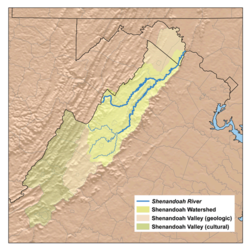Shenandoah Valley AVA
| Wine region | |
 | |
| Type | American Viticultural Area |
|---|---|
| Year established | 1982, amended 1987[1] |
| Country | United States |
| Part of | Virginia, West Virginia |
| Other regions in Virginia, West Virginia | Middleburg AVA, Monticello AVA, North Fork of Roanoke AVA, Northern Neck George Washington Birthplace AVA, Rocky Knob AVA, Virginia's Eastern Shore AVA |
| Climate region | Humid subtropical/maritime/continental |
| Precipitation (annual average) | 33 inches (84 cm)[2] |
| Total area | 2,400,000 acres (971,246 ha)[3] |
| Grapes produced | Cabernet Franc, Chambourcin, Chardonnay, Gewurztraminer, Riesling, Traminette, Viognier,[2] Norton, Cabernet Sauvignon, Merlot |
The Shenandoah Valley AVA is an American Viticultural Area located in the Shenandoah Valley of Virginia and West Virginia. The valley is bounded by the Blue Ridge Mountains to the east and the Appalachian and Allegheny Plateaus to the west. Most of the AVA is in Virginia, with a small portion in the Eastern Panhandle of West Virginia. Most of the vineyards in the AVA are located in Virginia and grow a wide variety of Vitis vinifera, Vitis labrusca, and French hybrid grapes.[2] The hardiness zone is mainly 7a except for some 6b in high areas.
The region is Virginia's first AVA, identified in 1982.[4] Limestone soil, which is common to the Valley, has been long associated with great wine growing regions in Europe.[5] The Shenandoah Valley AVA's climate allows grapes to attain higher acidity, generally regarded as good in wine.[6] The cooler, relatively dry climate, soil composition and position between two mountain chains makes the Shenandoah Valley more ideal for viticulture than any of the state's other regions.[7][8] The Shenandoah Valley is relatively dry, a "rain shadow" between the Blue Ridge and Allegheny Mountains;[9] the annual rainfall in the Valley is one half that of the Virginia average.[10] The growing season in the valley is distinctly warmer and drier than in neighboring Virginia regions, which don't have the natural rain barrier from the nearby mountains[10] and where, east of the Blue Ridge, vineyard soils are primarily clay and loam.[4][11] The conditions in the Shenandoah Valley AVA are thus more hospitable than those east of the mountains for Cabernet Franc, Chambourcin, Cabernet Sauvignon, Lemberger, Petit Manseng, Petit Verdot, Pinot Noir, and Riesling.[6][12]
List of Producers
[edit]Wine producers in the AVA include: (from north to south) Veramar Vineyard,[13] James Charles Winery & Vineyard,[14] Valerie Hill Vineyard & Winery,[15] North Mountain Vineyard & Winery,[16] Muse Vineyards,[17] Shenandoah Vineyards,[18] Wolf Gap Vineyard,[19] Cave Ridge Vineyard,[20] The Winery at Kindred Pointe,[21] DeMello Vineyards,[22] Old Hill Cidery,[23] Wisteria Farm & Vineyard,[24] CrossKeys Vineyards,[25] Bluestone Vineyard,[26] Marceline Vineyards,[27] Barren Ridge Vineyards,[28] Ox-Eye Vineyards,[29] Above Ground Winery,[30] Hunt's Vineyard,[31] Rockbridge Vineyard,[32] Jump Mountain Vineyard,[33] Lexington Valley Vineyard[34] and Blue Ridge Vineyard.[35] Briede Vineyards.
See also
[edit]References
[edit]- ^ "§ 9.60 Shenandoah Valley" (Title 27: Alcohol, Tobacco and Firearms; Part 9 — American Viticultural Areas; Subpart C — Approved American Viticultural Areas). Code of Federal Regulations. February 27, 1987.
- ^ a b c "Shenandoah Valley (VA) (AVA): Appellation Profile". Appellation America. 2007. Archived from the original on September 2, 2013. Retrieved January 30, 2008.
- ^ "American Viticultural Areas by State". Wine Institute. 2008. Archived from the original on January 27, 2008.
- ^ a b Berry, Camille (September 6, 2016). "The Wines of Virginia" (Articles). GuildSomm.
- ^ "Why Limestone Matters for Wine Grape Growing". Tablas Creek Vineyard Blog. May 26, 2010.
- ^ a b Scala, Erin (September 26, 2018). "Growing interest: Shenandoah Valley's unique climate spurs its wine resurgence". C-Ville.
- ^ Carpenter Hale, Sally (October 30, 2017). "Explore wine country in Virginia's scenic Shenandoah Valley". The Seattle Times.
- ^ "Shenandoah Valley Wineries". American Winery Guide.com.
- ^ "Climate of Virginia". www.virginiaplaces.org.
- ^ a b "Shenandoah Valley - Virginia Wine". Wine-Searcher.
- ^ Dupury, Jessica (September 27, 2018). "Rising American Wine Regions to Know". Guildsomm.
- ^ Williams, Megan (May 10, 2014). "Valley climate, culture unique for wine-making". The News Leader.
- ^ "Veramar Vineyard". Retrieved March 15, 2016.
- ^ "James Charles Winery". Retrieved March 15, 2016.
- ^ "Valerie Hill Winery". Retrieved March 15, 2016.
- ^ "North Mountain Vineyard & Winery". Retrieved March 15, 2016.
- ^ "Muse Vineyards". Retrieved March 15, 2016.
- ^ "Shenandoah Vineyards". Retrieved March 15, 2016.
- ^ "Wolf Gap Vineyard and Winery". Retrieved March 15, 2016.
- ^ "Cave Ridge Vineyard & Winery". Retrieved March 15, 2016.
- ^ "Kindred Pointe". Retrieved March 15, 2016.
- ^ "De Mello Vineyards". Retrieved March 15, 2016.
- ^ "Old Hill Cidery". Showalter's Orchard & Greenhouse. Retrieved March 15, 2016.
- ^ "Wisteria Vineyard". Retrieved March 15, 2016.
- ^ "CrossKeys Vineyards". Retrieved March 15, 2016.
- ^ "Bluestone Vineyard". Retrieved March 15, 2016.
- ^ "Marceline Vineyards". Retrieved November 11, 2022.
- ^ Higgs, John. "Barren ridge vineyards".
- ^ "Ox-Eye Vineyards". Retrieved March 15, 2016.
- ^ "Above Ground Winery". Retrieved March 15, 2016.
- ^ "Hunt's Vineyard". Archived from the original on March 16, 2016. Retrieved March 15, 2016.
- ^ "Rockbridge Vineyard". Retrieved March 15, 2016.
- ^ "Jump Mountain Vineyard". Virginia Wine. Retrieved March 15, 2016.
- ^ "Lexington Valley Vineyard". Retrieved March 15, 2016.
- ^ "Blue Ridge Vineyard". Retrieved March 15, 2016.
